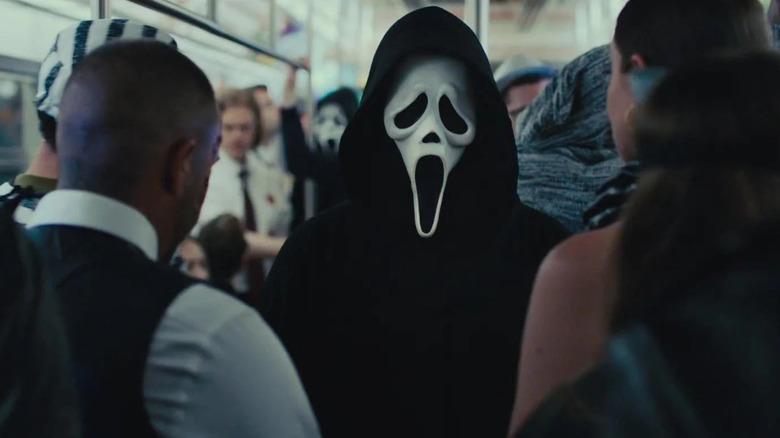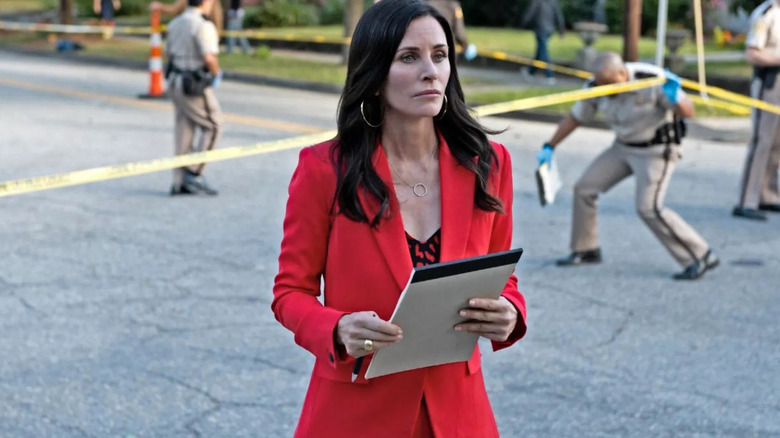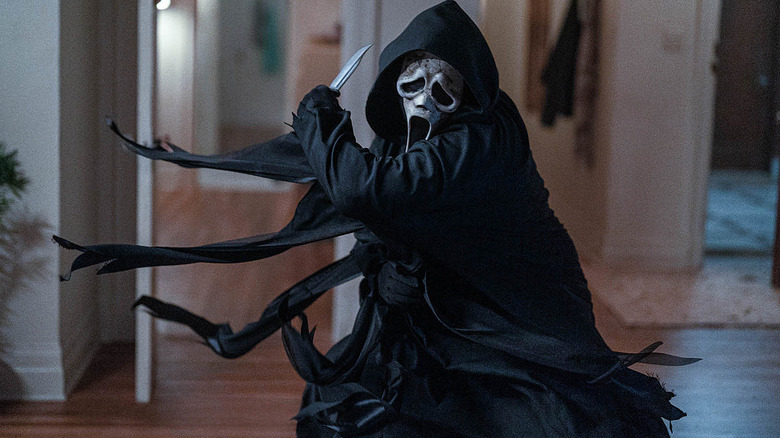How Scream 6's Cinematographer Turned A Disadvantage Into An Advantage For A Key Scene [Exclusive]
This post contains spoilers for "Scream VI."
In the middle of Matt Bettineli-Olpin's and Tyler Gillett's "Scream VI," the character of Gale Weathers (Courteney Cox) is relaxing in a rather posh high-rise apartment in New York City when the masked killer Ghostface attacks her. Given the nature of the "Scream" movies, the true identity of Ghostface hadn't yet been revealed, and he could be any number of people. Gale isn't so concerned with the identity of the killer when he appears in her flat, though, and has to run through hallways and hide in small rooms to elude being murdered. It's not distracting that Gale lives in a giant, expensive New York apartment, as she is a successful author whose true crime books were adapted into a popular series of slasher movies. (She's not merely lucky, like Cox's character on the hit sitcom "Friends.")
"Scream VI" was shot by cinematographer Brett Jutkiewicz, who shot the previous "Scream" movie, as well as the soulful sports drama "Boogie," the thriller "Ready or Not," and the supernatural horror movie "The Black Phone." These hit films came after a decade of photography on many smaller, independent productions. From the looks of his filmography, Jutkiewicz has truly paid his dues and earned his success.
In a new interview with /Film's own Cass Clarke, Jutkiewicz revealed that the layout of Gale Weathers' apartment initially provided problems in terms of clean lines and long shots. Specifically, two enormous load-bearing columns in the middle of the living room proved to interrupt a scene's visual clarity. Jutkiewicz, however, found that shooting around the columns and even using them as part of the attack scene's blocking ultimately proved to be a creative boon.
The real-life apartment
Gale's apartment was, Jutkiewicz revealed, not a set but an actual apartment that the filmmakers located. It had a real balcony, real sliding doors, and real columns. According to the interview, the film's stunt team and fight choreographers visited the set prior to shooting to work out just how a chase scene would play out in that space. They were careful to utilize elements of the production design into the chase, and Jutkiewicz described how the actual stunts were to be recorded on paper prior to shooting:
"What we wound up doing was creating an overhead diagram of the space and plotting out exactly where Gale and Ghostface would move in the space and how the choreography would progress through the space. That was important for us, that it really felt like it was progressing throughout and getting more intense and more scary as it goes. There's a little bit of cat and mouse, but then there's a little bit of straight fight choreography as well."
Jutkiewicz even remembers a piece of furniture, a bookcase that was specially built for the scene, that was to be destroyed by a flying human body. There was only one on hand, so multiple takes would have required repeated rebuilding of the item in question. Thankfully, Jutkiewicz revealed that rebuilding wasn't actually necessary:
"The bookcase that Ghostface throws Gale's boyfriend through was built by the art department and put into the space. So that was added, which was amazing and was able to break away like that. Luckily, we got that in one take, so we didn't have to rebuild the bookcase after."
Rows of columns
But then there was the issue of the gigantic support columns in the middle of the living room. While such features are natural and common in many high-rise apartments of that square footage, they aren't necessarily amenable to great movie scenes. Luckily, Jutkiewicz found a way to stage action around them. The night shoots also dictated that lighting would remain consistent on the frequent occasions where the cinematographer didn't have to cover the windows. He described the shoot like this:
"The big support columns in the space, when we first looked at it, we were like, 'Oh, we're going to have to deal with these big ugly columns.' But we wound up using them to our advantage and creating some choreography around them. But it was a challenge, since it's a practical location, we had to shoot at night for the most part. There were some parts where we were able to start a little earlier during the day and just black out the windows for things where we weren't really seeing out the windows."
The scene takes up only about seven or eight minutes of screen time, but it took multiple days to shoot. In terms of most movie productions, this is actually quite swift. It did require, however, at least one shooting day that lasted all night. It sounds exhausting, but Jutkiewicz was proud of his work:
"[T]hey were long nights ... we were there for three days. On the last day, we shot all night and we were still shooting as the sun was coming up. We had to pull down the blacks outside the windows at six in the morning. [...] But I'm really happy with how it came out. I think it's quite tense and scary."
Indeed. "Scream VI" is in theaters now.


